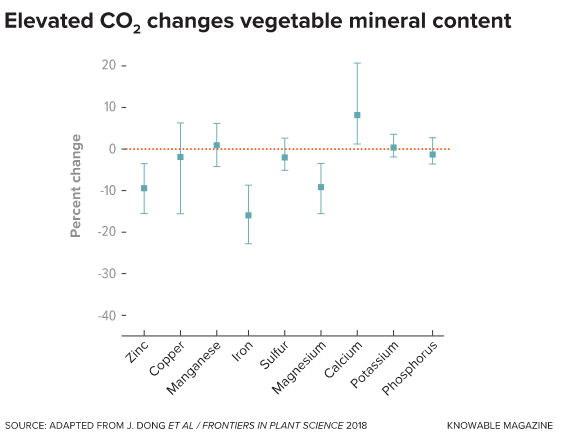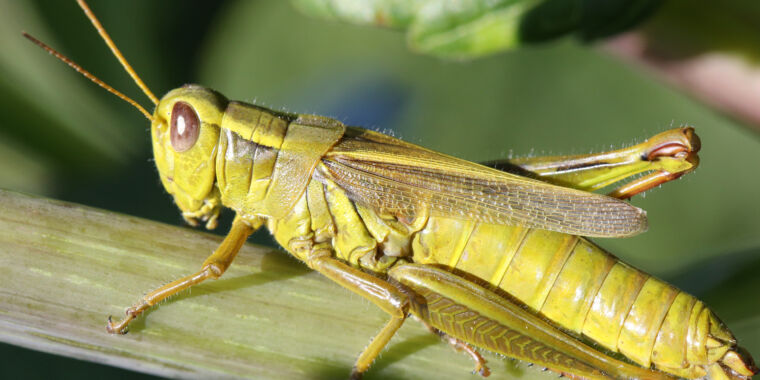It’s tough out there for a hungry grasshopper on the Kansas prairie. Oh, there’s plenty of grass to eat, but the grass of this century isn’t what it used to be. It is less nutritious and deficient in minerals such as iron, potassium and calcium.
According to a 2020 study, locust numbers have plummeted recently, in part due to that nutrient-poor diet, by about a third in two decades. The prairie isn’t hopping like it used to — and a major culprit is carbon dioxide, says study co-author Michael Kaspari, an ecologist at the University of Oklahoma in Norman.
Atmospheric carbon dioxide is the highest in human history. That’s probably fine for plants like the grasses the hoppers chew. They can convert that atmospheric carbon into carbohydrates and build more plants. In fact, plant biologists once thought that all that extra carbon dioxide would simply mean better crop yields. But experiments in crops exposed to high levels of carbon dioxide indicate that many food plants contain fewer other nutrients than they did under past carbon dioxide levels. Various studies show that, for example, the nitrogen content of plants has decreased, which indicates a lower vegetable protein content. And some studies suggest that plants may also be deficient in phosphorus and other trace minerals.
The idea that plants grown in the current carbon dioxide-rich era will contain less of certain other elements — a concept Kaspari categorizes as nutrient dilution — has been well studied in crops. Nutrient dilution in natural ecosystems has been less studied, but scientists have observed it in a variety of places, from the forests of Europe to the kelp forests of Southern California. Now researchers like Kaspari are starting to investigate the knock-on effects — to see if herbivores that eat these plants, such as locusts and grazing mammals, are affected.
The sparse data already available suggests that nutrient dilution may cause widespread problems. “I think we’re in canary-in-a-coalmine territory,” says Kaspari.
Lower quality food?
It is clear that rising carbon dioxide levels change the composition of plants in several ways. Scientists have done years of studies in which they pump carbon dioxide over crops to artificially increase their exposure to the gas, then test the plants for nutrients. One large analysis found that increasing carbon dioxide by about 200 parts per million increased plant mass by about 18 percent, but often reduced levels of nitrogen, protein, zinc and iron.
Vegetables like lettuce and tomatoes may be sweeter and tastier due to added high-carbon sugars, but lose about 10 to 20 percent of the protein, nitrate, magnesium, iron and zinc they have in low-carbon conditions, according to another large study. On average, plants can lose about 8 percent of their mineral content in conditions of elevated carbon dioxide. Kaspari likens the effect to swapping a nutritious kale salad for a bowl of iceberg lettuce that’s low in nutrients.

When vegetables are grown under elevated levels of carbon dioxide, they tend to grow larger and sweeter and may contain more of some minerals, such as calcium, an analysis of several studies found. But amounts of other minerals, including zinc and iron, may decrease.
Scientists don’t yet know exactly how extra carbon dioxide leads to changes in all those other nutrients. Kaspari, who discussed the importance of micronutrients like calcium and iron in ecosystems in the 2021 Annual Review of Ecology, Evolution and Systematics, suggests it’s a simple matter of proportions: carbon goes up, but everything else stays the same.
Lewis Ziska, a plant physiologist at Columbia University Mailman School of Public Health in New York City, thinks it’s more complicated than just ratios. For example, in the vegetable study, increased carbon dioxide increased the concentration of certain nutrients, such as calcium, while limiting levels of others.
A contributing factor may be plants’ tiny openings called stomata through which they absorb the carbon dioxide they use to make sugars and the rest of their structures. If there is enough carbon dioxide around, they don’t have to open the stomata as often or for as long. That means plants lose less moisture through evaporation from those openings. The result could be less fluid moving up the stem from the roots, and since that fluid carries elements such as metals from the soil, fewer of those trace elements will reach the stems and leaves.
Scientists have also posited that when carbon dioxide is high, plants are less efficient at absorbing minerals and other elements because the root molecules that normally draw these elements in work at a lower capacity. There are probably several processes involved, says Ziska. “It’s not a one-size-fits-all mechanism.”
Whatever happens in these well-studied crops, the same is likely happening in trees and weeds and other non-agricultural species, Kaspari says. “If it happens to the human food supply, it happens to everyone.”
Several studies suggest that Kaspari is right. For example, while farmers add nitrogen fertilizer to fields and then leach nitrogen into neighboring waterways or wild areas, nitrogen availability decreases in a variety of non-agricultural ecosystems. In one analysis, researchers examined nitrogen levels in more than 43,000 leaf samples collected in various studies between 1980 and 2017. Atmospheric carbon dioxide levels rose nearly 20 percent during that period, and leaf nitrogen levels fell 9 percent. Mineral concentrations are also affected: Scientists studying trees in Europe between 1992 and 2009 saw drops in several, including calcium, magnesium and potassium, in at least some of their leaf samples.
Scientists can also examine museum and herbaria samples to study how nutrient levels in plants have changed as Earth’s carbon dioxide levels have risen. Ziska and colleagues did this for goldenrod, an important source of food for bees. Using collections from the natural history museum at the Smithsonian Institution in Washington, D.C., they analyzed pollen from as far back as 1842, just before the American Industrial Revolution. At that time, carbon dioxide levels were 280 parts per million, compared to just over 420 today.
Pollen protein content, and therefore nutrient levels, dropped by about a third over time, the scientists found. Ziska’s modern experiments with goldenrod grown under carbon dioxide levels as high as 500 parts per million confirmed that more carbon dioxide yields low-protein pollen. While it’s not yet clear what this means for bees, it’s probably not good, says Ziska.
The results are striking, especially when compared to crop studies that don’t use large historical data sets, said Samuel Myers, a principal investigator at the Harvard TH Chan School of Public Health, who has examined the link between pollinator health and human nutrition. .

